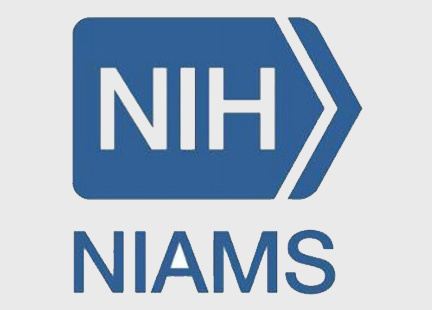
Spotlight on Research 2012
January 2012 (historical)
Scientists Gain New Insights into Genetic Mechanisms of Ankylosing Spondylitis
New research supported, in part, by the National Institute of Arthritis and Musculoskeletal and Skin Diseases (NIAMS), has brought scientists a step closer to understanding the genetic mechanisms underlying ankylosing spondylitis, a chronic inflammatory form of arthritis that predominantly affects the spine and pelvis.
For almost three decades, scientists have known that a genetic marker called human leukocyte antigen (HLA)-B27 is associated with the development of ankylosing spondylitis, a disease that can lead to spinal fusion and internal organ damage if inflammation is not stopped. Up to 90 percent of people with the disease have the marker, which is part of a family of genes that plays a central role in the immune system. But while most people with ankylosing spondylitis have the genetic marker, only a small percentage—perhaps one to five percent—of people with the gene develop the disease, suggesting other genes and factors are involved.
The study identified several new genetic regions associated with ankylosing spondylitis risk, and offered new insights into how another recently identified gene, ERAP1, interacts with HLA-B27 in the disease.
The first finding of the study, published in the journal Nature Genetics, was of a tag SNP—a small DNA marker that sits close to HLA-B27 in the gene cluster on chromosome 6—that serves as a proxy for HLA-B27 and enables researchers to screen for HLA-B27 more easily and less expensively, says John D. Reveille, M.D., professor and director of the Division of Rheumatology and Clinical Immunogenetics at the University of Texas (UT) Medical School at Houston.
Finding the tag SNP enabled Dr. Reveille and Dr. Matthew Brown at the University of Queensland, and their colleagues, to conduct analyses on ankylosing spondylitis patients and controls that showed an interaction between ERAP1 and HLA-B27. ERAP1 codes for an enzyme that plays a role in the processing of antigens—molecules that are recognized with great specificity by the immune system. The processing step involves trimming an antigen molecule to an optimal length for presentation to cells that activate the immune system. The study shows that ERAP1 is associated with ankylosing spondylitis only in people who are HLA-B27 positive, pointing to a possible key mechanism by which HLA-B27 contributes to the development of ankylosing spondylitis through the aberrant processing of antigens by ERAP1.
Dr. Reveille says further research is needed to better understand the implications of the ERAP1—HLA-B27 interaction, as well as other genes and processes involved in the disease’s development.
While current treatments are often effective in slowing inflammation once it has started, Dr. Reveille hopes that a better understanding of what leads to inflammation will allow for the development of therapies to address what initiates it in the first place.
This work was also supported by the NIAMS Intramural Research Program, the Australo-Anglo-American Spondyloarthritis Consortium and the Wellcome Trust Case Control Consortium 2.
The mission of the National Institute of Arthritis and Musculoskeletal and Skin Diseases (NIAMS), a part of the U.S. Department of Health and Human Services’ National Institutes of Health (NIH), is to support research into the causes, treatment, and prevention of arthritis and musculoskeletal and skin diseases; the training of basic and clinical scientists to carry out this research; and the dissemination of information on research progress in these diseases. For more information about the NIAMS, call the information clearinghouse at (301) 495-4484 or (877) 22-NIAMS (free call) or visit the NIAMS website at https://www.niams.nih.gov.
###
Evans DM, Spencer CC, Pointon JJ, Su Z, Harvey D, Kochan G, Oppermann U,Dilthey A, Pirinen M, Stone MA, Appleton L, Moutsianas L, Leslie S, Wordsworth T,Kenna TJ, Karaderi T, Thomas GP, Ward MM, Weisman MH, Farrar C, Bradbury LA,Danoy P, Inman RD, Maksymowych W, Gladman D, Rahman P; Spondyloarthritis Research Consortium of Canada (SPARCC), Morgan A, Marzo-Ortega H, Bowness P, Gaffney K, Gaston JS, Smith M, Bruges-Armas J, Couto AR, Sorrentino R, Paladini F, Ferreira MA, Xu H, Liu Y, Jiang L, Lopez-Larrea C, Díaz-Peña R, López-Vázquez A, Zayats T, Band G, Bellenguez C, Blackburn H, Blackwell JM, Bramon E, Bumpstead SJ, Casas JP, Corvin A, Craddock N, Deloukas P, Dronov S, Duncanson A, Edkins S, Freeman C, Gillman M, Gray E, Gwilliam R, Hammond N, Hunt SE, Jankowski J, Jayakumar A, Langford C, Liddle J, Markus HS, Mathew CG, McCann OT, McCarthy MI, Palmer CN, Peltonen L, Plomin R, Potter SC, Rautanen A, Ravindrarajah R, Ricketts M, Samani N, Sawcer SJ, Strange A, Trembath RC, Viswanathan AC, Waller M, Weston P, Whittaker P, Widaa S, Wood NW, McVean G, Reveille JD, Wordsworth BP, Brown MA, Donnelly P; Australo-Anglo-American Spondyloarthritis Consortium (TASC); Wellcome Trust Case Control Consortium 2 (WTCCC2). Interaction between ERAP1 and HLA-B27 in ankylosing spondylitis implicates peptide handling in the mechanism for HLA-B27 in disease susceptibility. Nat Genet. 2011 Jul 10;43(8):761-7. doi:10.1038/ng.873. Erratum in: Nat Genet. 2011 Sep;43(9):919.
